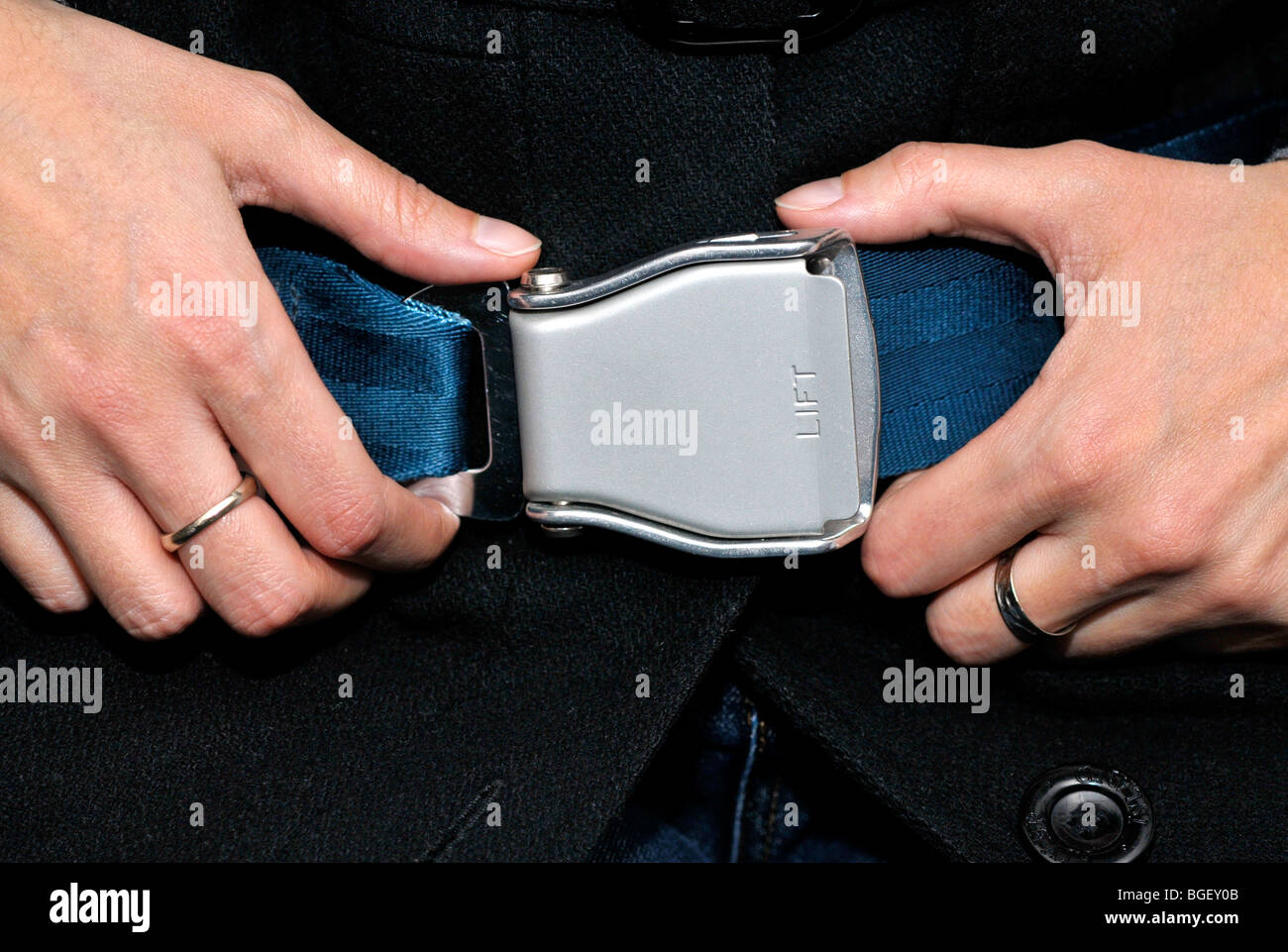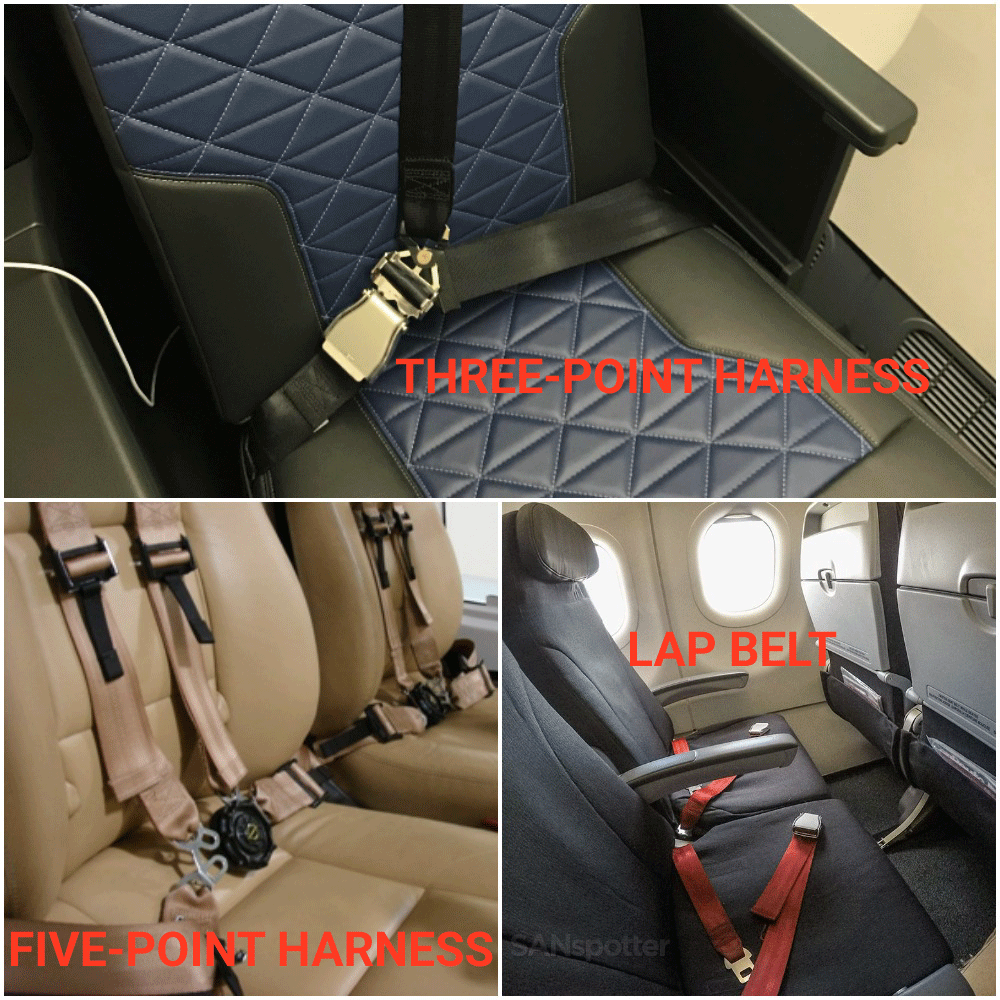Aircraft Seatbelts - Standard economy class airplane seats have certain features. The tray table on the back of the front seat is secured with push-in plastic pins. A button on the armrest is a button to recline the seat, which is either very rude or totally fine depending on your perspective and possibly the time of the flight. And then there's the seat belt.
What happened to that seat belt? It is unlike any other seat belt. It's just a two-piece belt with an industrial-style round belt that sits in the middle of the pelvis. Car seat belts are not. Not even race car seat belts. In fact, other modern seat belts are no different. It seemed like an appropriate, even innocuous topic to investigate.
Aircraft Seatbelts

The FAA denied the access request. AmSafe, perhaps the largest maker of airplane seat belts, did not respond to repeated requests for comment. Various aviation safety experts either did not respond, said they knew nothing about the seat belts or declined to comment. A famous producer is interviewed. Two nice engineers answered my questions and then asked me not to use their names in any article. Amy Fraher, author
Autoflug 2 Point Seat Belt Aviation Lap Seatbelt Aircraft Grey
Seat belts or seat belts or restraint systems have been around long before airplanes and even cars were first patented in the United States in 1885. They weren't found on early cars, and were at best an option on some forward-thinking automaker lines until the late 1950s, especially Saab. In 1966, Ralph Nader's book was published
Attacked the auto industry for refusing to include basic safety features in cars, leading to America's first law requiring seat belts in all vehicles (except buses).
Seat belts became common on airplanes in the 1930s and 1940s, although the airline industry protested in 1947. .
Fastening seat belts.) The Federal Aviation Act of 1958, spurred by several plane crashes, began a movement toward better safety requirements. These were codified in 1972 and have been updated periodically since then.
Latest Seat Belt Extender For New Southwest 737 800 Airplanes
The specific money I'm talking about was the old method in 1972, widely used in economics classes. It's known in the industry as a "boost package" and has been common in early mass markets for decades. market cars, but in the early 1970s they were replaced by so-called "push-button" packages, some version of which you may now have in your beautiful modern car. At the time, some automakers, especially luxury or more experimental automakers (read: Swedish automakers) were also playing around with what were known as three-point seat belts. It's the standard seat belt in today's cars: it's a two-piece harness that includes a shoulder strap that goes across the chest and a lap belt that goes around the waist.
There are several reasons why an elevator lap belt may disappear from a car but not from an airplane. One is that the shoulder strap on the car is attached to the frame of the car, which is a very strong part of the car. In aircraft, it must be attached to a non-fixed wall ("ball"). You can attach it to the seat, but you need to reinforce the seat, which we don't reinforce.
The blade itself has the benefit of being relatively secure - difficult to open accidentally, but relatively easy in an emergency. A car-style knick-knack bag, usually strapped to the waist, may cause impact if something hits the button. Given the limited space in economy class, no one wants to wander between the seats and find a lock in case of a malfunction.

The Liftlever lap belt has remained unchanged for decades, except for changes in the material of the belt. This makes them deliciously affordable for popular budget-focused airlines. "I still question the acceptability of the stupid outdated seat belts we use as passengers because they've been proven to meet the FAA's minimum safety requirements in a crash, they're lightweight, and they're cheap," Faher writes.
Amsafe / American Safety Aircraft Seat Belt / Lap Belt Set 449345 449350
But being cheap isn't the end of the story. Airplane safety is different from car safety because airplanes are different from cars. The primary purpose of an airplane seat belt is not to save your life in the event of a plane crash. In this unlikely event, traditional safety gear has little place to help. If you can survive a totaled car accident, your chances of surviving a comparable plane crash are significantly less rosy. Therefore, airplane seat belts are designed to keep passengers in place during small and frequent incidents such as turbulence or runway collisions. What are you in these situations?
Unwanted, unsafe in a speeding car is free to slam your squishy body into walls, ceilings, seats, and other people.
Another important difference is the way airplanes move compared to cars. Car accidents usually involve moving forward, backward, or sideways as vehicles are on the ground. With this risk, you want your shoulder harness: it prevents your whole body from bouncing due to sudden acceleration or deceleration. But on a plane, you might want to protect yourself from turbulence without hesitation. And the shoulder strap doesn't do you much good.
Because seat belts in airplanes have a different purpose than seat belts in cars, they are allowed to be different. The dimension to be aware of here is called "pitch", which is the distance between your seat and the seat in front of you (or the wall in front of you, or the wall next to you, or anything around you).
Aircraft Seatbelt Buckle Key Holder
FAA safety requirements are defined as safety incidents by placing a chair with an accelerometer on the head. The speed at which the drum head can travel before it hits something will determine what type of safety gear you need. The faster, the more protection you need. Faster speeds are more dangerous. If this is a confusing idea, you can try gently banging your head against the wall and then hitting the wall. When you become conscious, you understand how it works.
The farther away your notch is from the surrounding obstacles, the faster you'll accelerate through the room and the faster your delicate brain will burn. So FAA regulations mean that the more space you have, the tighter your restrictions should be. In an economy seat, all you can really hit is the flat seat in front of you, which is also about 25cm from your face, which doesn't give you much room to accelerate, thus reducing your need to restrain yourself. In first grade? They have more space and risk, so the few planes that introduce three-point seat belts like those in cars are in first or business class. (Also, seat belts are expensive to replace.)
Demand is even stronger for pilots and aircrew. A pilot has plenty of room to move around and plenty of sharp objects to hit in the event of a crash or crash. So pilots usually have a five-point seat belt, similar to what you see in the cockpit of a race car. Small planes are the same. Shoulder harnesses have been mandatory for all passengers on light aircraft since 1986, and while pilots may sometimes scoff at them, the magazine notes just how important they are.

Seat belts are sufficient under current FAA regulations as seat belts in economy class. In interviews with injury research experts, there is little data on how shoulder belts and other restraint systems affect the safety of airplane passengers. With no data to prompt airlines to invest in other equipment, they are perfectly content to follow the letter of the law.
American Safety Aircraft Seat Belt Model 449470, P/n 500810 H 0585, New Surplus!
As early as 1993, an FAA circular made a strong case for installing three-point shoulder belts like cars. Quote: “Crash experience provides strong evidence that seat belts with reinforced seat belts can reduce severe head, neck, and upper body injuries and have the potential to reduce crash fatalities. Otherwise it's a survival phenomenon."
And yet, the FAA didn't seem to have much faith in aviation cooperation. Also from this circle: “One often hears that shoulder harnesses are cumbersome, cumbersome, hot and uncomfortable to use. Such objections to lack of installation and use of shoulder straps
Dog seatbelts, mustang seatbelts, rzr seatbelts, cat seatbelts, wheelchair seatbelts, universal seatbelts, rewebbing seatbelts, mgb seatbelts, seatbelts plus, seatbelts, forklift seatbelts, retractable seatbelts
0 Comments